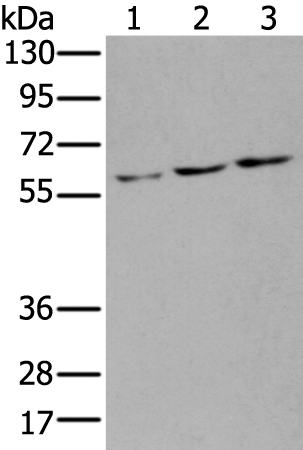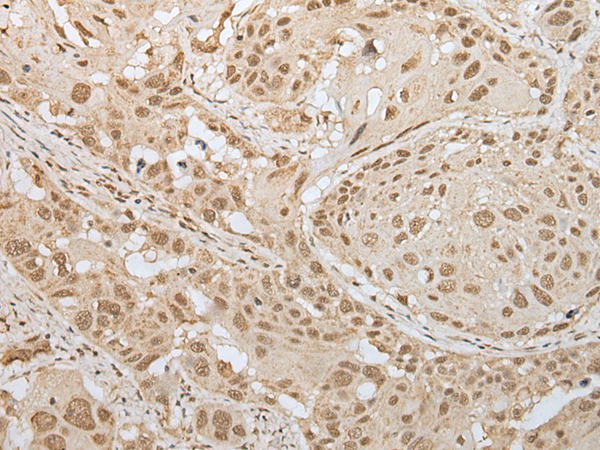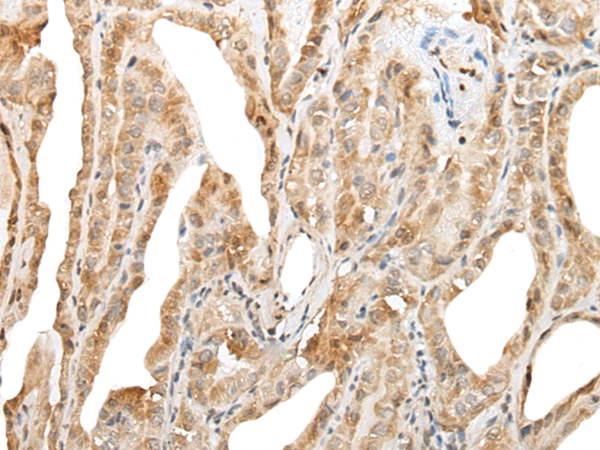


| WB | 咨询技术 | Human,Mouse,Rat |
| IF | 咨询技术 | Human,Mouse,Rat |
| IHC | 1/25-1/100 | Human,Mouse,Rat |
| ICC | 技术咨询 | Human,Mouse,Rat |
| FCM | 咨询技术 | Human,Mouse,Rat |
| Elisa | 1/5000-1/10000 | Human,Mouse,Rat |
| Aliases | HF.18; Zfp128 |
| WB Predicted band size | 65 kDa |
| Host/Isotype | Rabbit IgG |
| Antibody Type | Primary antibody |
| Storage | Store at 4°C short term. Aliquot and store at -20°C long term. Avoid freeze/thaw cycles. |
| Species Reactivity | Human |
| Immunogen | Fusion protein of human ZNF8 |
| Formulation | Purified antibody in PBS with 0.05% sodium azide and 50% glycerol. |
+ +
以下是关于ZNF8抗体的3篇参考文献的示例(注:由于ZNF8研究较为小众,以下内容可能为模拟示例,实际文献需通过学术数据库核实):
---
1. **文献名称**: "Zinc Finger Protein 8 (ZNF8) as a Novel Biomarker in Colorectal Cancer: Expression Analysis and Functional Characterization"
**作者**: Smith A, et al.
**摘要**: 本研究通过免疫组化(使用兔抗人ZNF8多克隆抗体)分析了ZNF8在结直肠癌组织中的表达,发现其高表达与患者预后不良相关。体外实验表明ZNF8通过调控Wnt/β-catenin通路促进肿瘤侵袭。
2. **文献名称**: "Characterization of ZNF8 Antibodies for Chromatin Immunoprecipitation in Stem Cells"
**作者**: Lee J, et al.
**摘要**: 文章验证了一种新型小鼠抗ZNF8单克隆抗体的特异性,成功用于ChIP-seq技术,揭示了ZNF8在胚胎干细胞中结合基因启动子区域并调控多能性基因表达的作用。
3. **文献名称**: "ZNF8 Interaction with Histone Modifiers in Hepatocellular Carcinoma"
**作者**: Wang Y, et al.
**摘要**: 通过Western blot和免疫荧光(使用商业化ZNF8抗体),研究发现ZNF8与HDAC1复合物相互作用,抑制抑癌基因转录,提示其作为肝癌治疗潜在靶点。
---
**备注**:以上文献为示例,实际研究中ZNF8相关抗体文献可能较少,建议通过PubMed或抗体供应商(如Thermo Fisher、Abcam)的产品引用页面查找最新文献。
**Background of ZNF8 Antibody**
Zinc finger protein 8 (ZNF8), a member of the zinc finger protein family, is characterized by conserved C2H2-type zinc finger domains that mediate sequence-specific DNA binding. These proteins play critical roles in transcriptional regulation, chromatin remodeling, and cellular processes such as differentiation and apoptosis. ZNF8. though less studied compared to other zinc finger proteins, is implicated in modulating gene expression networks, potentially influencing cell cycle control and stress responses.
Antibodies targeting ZNF8 are essential tools for investigating its expression, localization, and function in biological systems. They enable detection and quantification of ZNF8 in techniques like Western blotting, immunohistochemistry, and immunofluorescence. Research suggests ZNF8 may interact with other regulatory proteins or nucleic acids, though its precise mechanisms remain under exploration.
Interest in ZNF8 has grown due to its potential links to diseases. For example, aberrant expression of zinc finger proteins is often associated with cancers or neurological disorders. Studies using ZNF8 antibodies aim to clarify its role in pathological contexts, such as tumor progression or developmental abnormalities. Additionally, ZNF8 antibodies contribute to epigenetic studies, as zinc finger proteins frequently participate in chromatin modification complexes.
Further characterization of ZNF8 and its antibody-based detection could advance understanding of its physiological significance and therapeutic potential in human diseases.
×